Ash Gourd Farming
Ash gourd (Benincasa hispida), is an important cucurbit crop valued for its large fruits and medicinal properties. This robust vine thrives in warm climates with well-drained soils and requires careful management of irrigation, nutrients, and pest control to achieve its maximum yield potential.
The fruit is highly versatile, used both fresh and in processed forms such as sweets, beverages, and various culinary dishes, as well as in traditional medicinal practices. Its excellent storage and transport qualities, coupled with strong market demand, highlight the significant ash gourd farming profit per acre, making it a commercially attractive and sustainable option for vegetable cultivation.
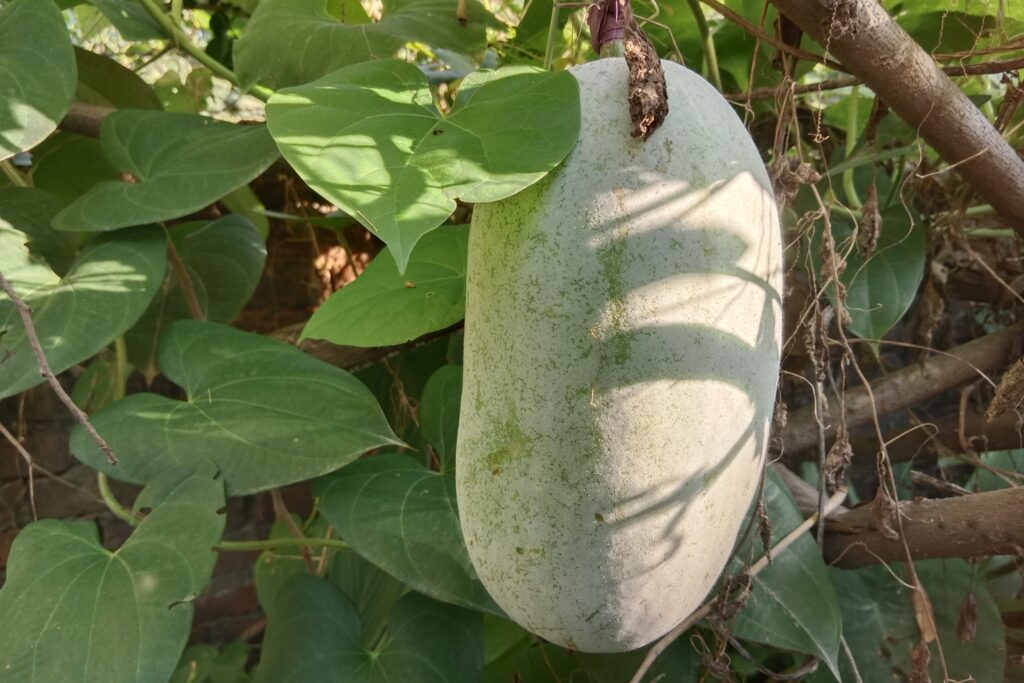
For agricultural entrepreneurs seeking a high-return venture, understanding the potential ash gourd farming profit per acre is the first step toward a successful investment. This cultivation practice can be a remarkably profitable endeavor, particularly when diligent management and modern agricultural techniques are implemented. A detailed financial breakdown for a typical one-acre plot reveals a substantial yield of approximately 20,000 kg.
With a conservative market price of NRs. 10 per kg, this output translates to a robust gross income of NRs. 200,000. After accounting for all comprehensive production and operational costs, which are estimated at NRs. 51,000 per acre, farmers can anticipate a striking net profit of NRs. 149,000. This results in an exceptional profit margin of 292.2%, solidifying ash gourd’s status as a highly lucrative and financially rewarding option for growers aiming to maximize their returns from commercial vegetable farming.
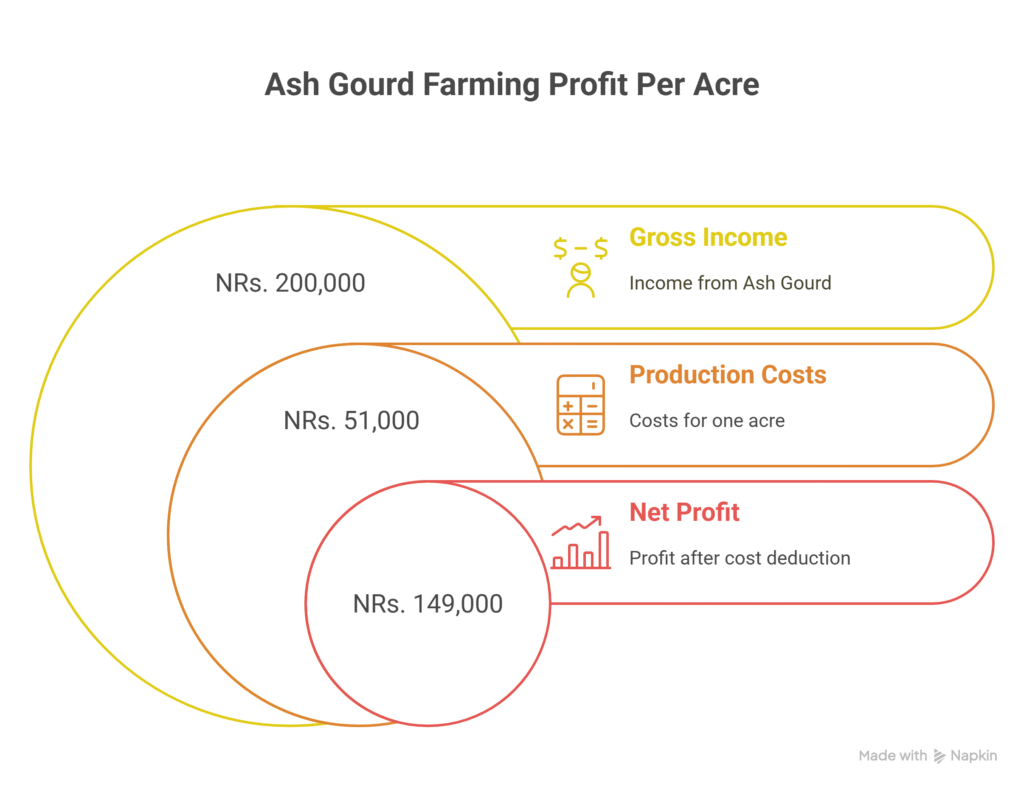
Land Preparation
Land preparation is a vital step in ash gourd cultivation as it ensures a weed-free, well-aerated, and well-drained environment for healthy root development and vine spread. The process begins with deep plowing (20–25 cm) using a moldboard plow to bring subsoil to the surface, bury crop residues, improve aeration, and suppress soil-borne pests.
After plowing, the soil should be left to weather for about a week, followed by 2–3 cross harrowings with a disc harrow to break clods and achieve a fine tilth. During the final harrowing, well-decomposed Farm Yard Manure (FYM) or compost at the rate of 15–20 tons per acre is incorporated into the soil to enhance fertility.
Finally, raised beds or furrows measuring 1.5–2 meters in width are prepared to facilitate proper drainage, which is essential since ash gourd is highly susceptible to waterlogging.
Soil Type
The optimal growing conditions for ash gourd are sandy loam to loam soils that drain well and are enriched with organic matter. This creates the perfect environment for ash gourd growth and yield. In order to ensure adequate nutrient availability, the crop prefers a pH range of 6.0 to 7.0, which is slightly acidic to neutral. Avoid heavy clay soils with inadequate drainage because they raise the danger of root rot and waterlogging, two conditions that can negatively impact crop performance.
Climatic Requirements
As a warm-season crop that cannot withstand extremely low temperatures and is susceptible to frost, ash gourds do best in temperatures between 25°C and 30°C. It thrives in areas with moderate rainfall (600–1000 mm), yet too much rain during the flowering and fruiting stages might reduce pollination and raise the danger of disease. Sunlight conditions are important for good cultivation because it is necessary for aggressive growth and better harvests.
Major Ash Gourd Cultivars
| Cultivar Name | Key Characteristics | Maturity (Days) | Average Fruit Weight | Yield Potential |
| CO 1 & CO 2 | High-yielding, suitable for South India. | – | – | – |
| Pusa Ujjwal | Light green, tender fruits. | – | – | – |
| Pusa Hybrid 3 | Early-maturing, high-yielding hybrid. | – | – | – |
| APAG Shri Satya | Long, cylindrical fruits, high yield. | – | – | – |
| PAG-3 (2003) | Medium vines, appealing spherical fruits. | 145 | 10 kg | 120 q/acre |
| Kashi Surbhi | Oblong, ellipsoid fruit; greenish-white rind; suitable for transport. | – | 10-12 kg | 240 q/acre (Kharif), 210 q/acre (Summer) |
| Kashi Dhawal | Oblong fruit, high flesh recovery; ideal for Petha sweets. | 120 | 11-12 kg | 230-240 q/ha |
| Local Varieties | Regional landraces well-adapted to local conditions. | Varies | Varies | Varies |
Propagation
Ash gourd is exclusively propagated through seeds.
Seed Rate per Acre
The recommended seed rate is 1.5 to 2 kg per acre, which is sufficient for good crop establishment.
Nursery Management
In order to prevent seed-borne illnesses, nursery management starts with appropriate seed treatment. Seeds can be treated with bio-agents like Trichoderma viride at a rate of 4 g per kg or fungicides like Thiram or Carbendazim at a rate of 2 g per kg.
After treatment, the seeds are sown in protrays with 98 cells or in small polybags. These should be filled with a sterile medium made of coco peat, vermiculite, and farmyard manure (FYM) to ensure healthy germination.
The nursery should be maintained in a protected environment, such as a polyhouse or under a shade net. This helps shield young seedlings from heavy rains and pests while maintaining proper growing conditions. Regular watering is essential for strong growth.
Seedlings are generally ready for transplanting within 2–3 weeks, once they have developed 2–3 true leaves. This stage ensures they are strong enough to establish well in the main field.
Planting
a). Planting Season
In the plains, the main sowing periods are from January to March and again from September to December, while in the hills, sowing is typically carried out between March and May. in the plains, the main sowing periods are from January to March and again from September to December, while in the hills, sowing is typically carried out between March and May.
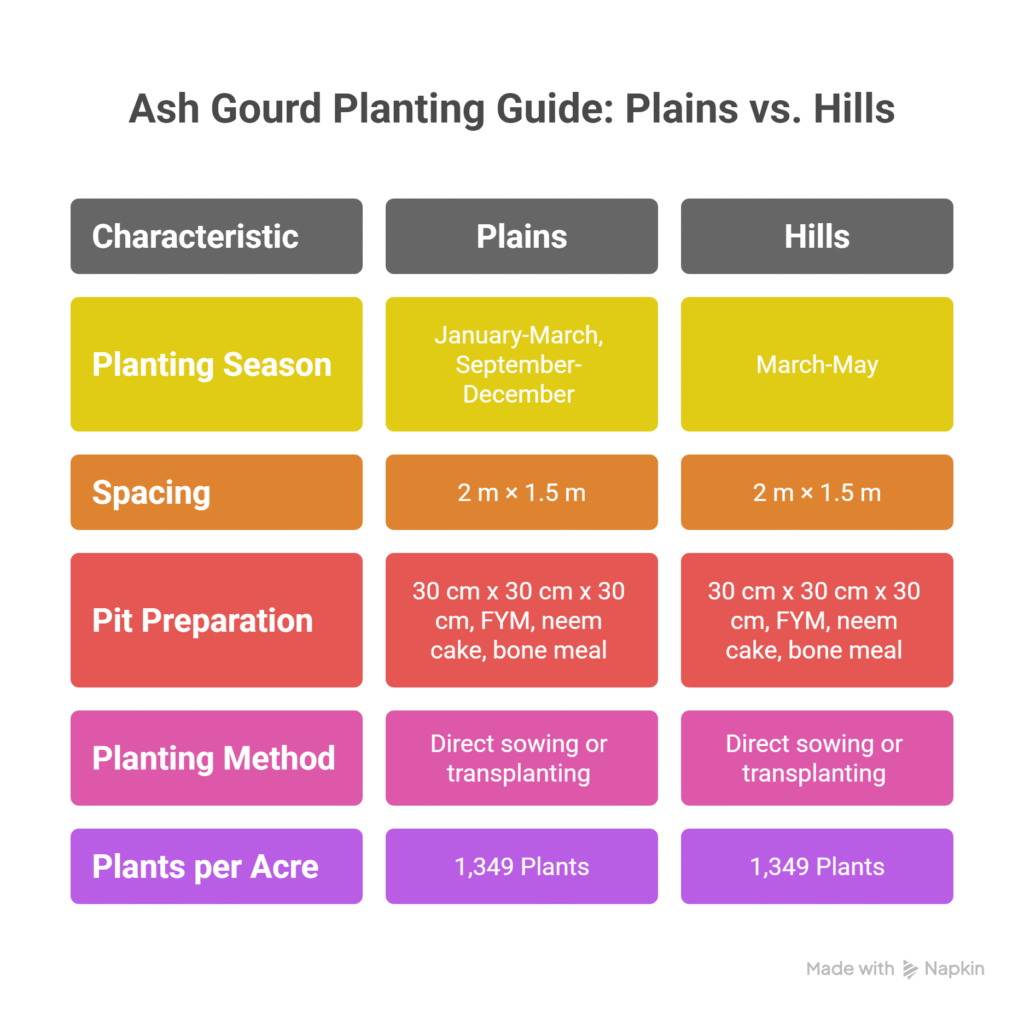
b). Spacing
For ash gourd planting, maintain a spacing of 2 m × 1.5 m between plants and prepare basins at each planting spot to support proper growth and irrigation.
c). Pit Preparation
For pit preparation, dig pits of 30 cm × 30 cm × 30 cm at the recommended spacing and fill them with a mixture of topsoil, 5–10 kg of well-decomposed farmyard manure (FYM), 250 g of neem cake, and 50 g of bone meal, creating a nutrient-rich micro-environment that supports healthy establishment and early growth of the young plants.
d). Planting Method
Planting can be done either by direct sowing or transplanting. In direct sowing, 2–3 seeds are placed per pit at a depth of 2–3 cm, and after germination, thinning is carried out to retain only the healthiest seedling. In transplanting, a healthy nursery-raised seedling is placed in the center of the prepared pit and watered immediately to ensure proper establishment.
e). Number of Plants per Acre
At a spacing of 2m x 1.5m, the number of pits per acre is approximately 1,349 Plants.
Intercropping
Because ash gourd requires wide spacing and shows relatively slow initial growth, short-duration crops such as radish, spinach, coriander, or bush beans can be cultivated as intercrops during the first 1–2 months. This practice ensures better utilization of land while also offering farmers an opportunity for additional income.
Irrigation
Depending on soil moisture and weather, watering should start with a light application right after planting and continue every three to four days during the early growth period. The most crucial time for water supply is during the flowering and fruiting stage, when regular soil moisture must be maintained by irrigation once a week or more frequently if needed. Drip irrigation is strongly advised since it reduces the danger of illness, conserves water, inhibits the growth of weeds, and keeps foliage dry. Waterlogging and late-night irrigation should be avoided.
Fertilizer and Manure Application for High Yield
| Application Stage | Timing | Inputs per Acre | Additional Notes |
| Basal Dose | At the time of pit preparation | • FYM: 15-20 tons • Nitrogen (N): 40 kg • Phosphorus (P₂O₅): 50 kg • Potassium (K₂O): 40 kg | Example Sources: • 87 kg Urea • 310 kg Single Super Phosphate (SSP) • 67 kg Muriate of Potash (MOP) |
| Top Dressing (1st Dose) | 30 days after planting | • Nitrogen (N): 20 kg | Apply in a ring around the plant. Incorporate lightly into the soil followed by irrigation. |
| Top Dressing (2nd Dose) | At the time of flowering | • Nitrogen (N): 20 kg | Apply in a ring around the plant. Incorporate lightly into the soil followed by irrigati |
Weed Control
Two to three manual hand weedings or hoeings should be done during the first thirty to forty-five days in order to prevent competition with immature plants. Black plastic or dry straw mulching around the base of the plants keeps the fruits clean, inhibits weed growth, and preserves soil moisture. Pendimethalin (1 liter per acre) can also be used as a pre-emergence herbicide to control weeds prior to planting, and then the weeds can be regularly pulled by hand.
Inter culture operation
Interculture operations for ash gourd include training and selective pruning. Training the vines on a bower system (overhead pandal) is highly beneficial as it saves space, improves air circulation, increases sunlight exposure for leaves, keeps fruits uniform and clean, and significantly reduces disease and pest problems.
If a bower system is not feasible, vines can be allowed to spread on the ground over a straw mulch base. While pruning is not commonly practiced, removing a few weak or late-formed secondary branches during the initial growth stage can help redirect the plant’s energy toward better fruit development.
Flowering and Fruit Management
Ash gourd is a monoecious plant, producing separate male and female flowers on the same plant, with bees and other insects serving as the primary pollinators. Poor fruit set may occur if pollinators are scarce or if rain disrupts flowering, in which case hand pollination can be performed, especially in protected cultivation. Thinning is generally unnecessary, but removing misshapen or diseased fruits can help improve the size and quality of the remaining fruits.
Pest and Disease Management
Common Pests
Fruit Fly
The fruit fly is one of the most destructive pests of ash gourd. Adult flies lay eggs just under the fruit skin, and the emerging larvae feed inside, causing fruit rotting and yield loss. Management practices include placing pheromone traps at a rate of 10 traps per acre to attract and capture adults.
Bait sprays can be prepared by mixing Malathion 50% EC at 5 ml per liter of water with Gur (jaggery) or sugar and applied on fruit surfaces weekly. Bagging individual fruits using polythene or paper bags can prevent egg-laying, and any infected fruits should be collected and destroyed to prevent further infestation.
Red Pumpkin Beetle
Growth is inhibited by this bug, which mainly feeds on seedlings and foliage. To discourage adult beetles, management involves applying 50 kg of neem cake per acre to the soil prior to planting. When beetle populations are large, foliar sprays of Malathion 50% EC at a rate of 2 milliliters per liter of water might be used. Infestation can also be decreased by hand-picking beetles on time.
Aphids & Whiteflies
These insects suck plant sap, weakening plants and transmitting viral diseases. Management includes spraying systemic insecticides such as Imidacloprid 17.8 SL at 0.5 ml per liter or Acetamiprid 20 SP at 0.5 g per liter of water. Additionally, using yellow sticky traps in the field can help monitor and reduce adult populations. Regular monitoring and early intervention are key to effective control.
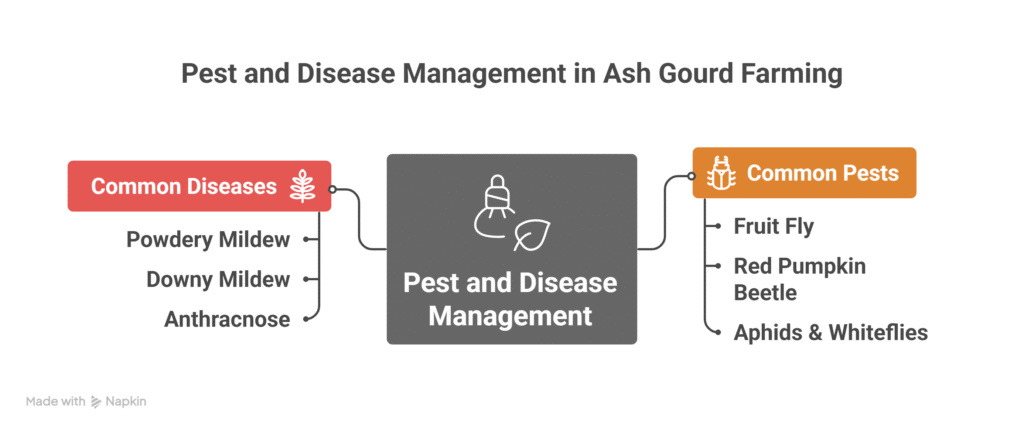
Common Diseases
a) Powdery Mildew
Powdery mildew is a fungal infection that manifests as white, powder-like spots on leaves, stems, and occasionally fruits, hindering photosynthesis and affecting plant growth. It can be controlled by spraying Wettable Sulfur at 2 g per liter of water or Dinocap at 0.5 ml per liter. For systemic protection, Hexaconazole at 1 ml per liter of water may be used. Applying sprays regularly during the initial stages of infection helps manage the disease effectively and limits its spread.
b) Downy Mildew
Downy mildew is a fungal infection that presents as yellow, angular spots on the top of leaves and purplish or grayish growth beneath, favoring humid and wet environments and leading to severe leaf damage. Control can be achieved by spraying Mancozeb at 2 g per liter of water or a combination fungicide such as Metalaxyl + Mancozeb at 2 g per liter. Initiating treatment at the earliest signs of infection and repeating every 7–10 days effectively limits disease development and spread.
c) Anthracnose
Anthracnose is a fungal infection that causes brown, sunken spots on fruits, leaves, and stems, often resulting in fruit rot and leaf drop, which can significantly lower yields. Control measures begin with treating seeds with a suitable fungicide to prevent early infection. For existing outbreaks, apply Chlorothalonil at 2 g per liter or Mancozeb at 2 g per liter, making sure to thoroughly cover all affected parts for effective disease management.
Harvesting
The timing of harvesting varies based on the intended use of the crop. For the fresh market, fruits are collected when they are still immature and tender, displaying a shiny green surface with a white ash coating, typically 55–70 days after sowing, with skin that can be easily pierced by a thumbnail.
For storage or processing purposes, fruits are harvested at full maturity, when the skin hardens, the ash layer thickens, the flesh becomes firm and white, and the tendril near the fruit dries. Fruits should be carefully cut using a sharp knife or secateur, leaving a 5–10 cm stalk, and handled gently to avoid bruising.
Yield
Yield varies significantly based on the variety, season, and management practices, with open-pollinated varieties typically producing 15–25 tons per acre under optimal conditions.
Cost of Investment per Acre for Ash Gourd Farming
| S.N. | Categories | Cost for Investment (NRs.) |
| 1 | Land Preparation | 15,000 |
| 2 | Seed | 2,000 |
| 3 | Sowing | 5,000 |
| 4 | Fertilizers and Manure | 8,000 |
| 5 | Irrigation | 5,000 |
| 6 | Weed Control (pre & post-emergence) | 3,000 |
| 7 | Pest & Disease Control | 3,000 |
| 8 | Harvesting | 5,000 |
| 9 | Miscellaneous Costs | 5,000 |
| Total Investment Cost | 51,000 |
Income per acre from Ash Gourd Farming
| Particulars | Estimated Yield / Acre (Kg) | Market Price (NRs / kg) | Total Income (NRs.) |
| Ash Gourd Yield | 20,000 | 10 | 200,000 |
| Total Income | 200,000 |
Analysis of Ash Gourd Farming Profit Per Acre
| Metric | Calculation | Amount (NRs.) |
| Total Income | 20,000 kg × NRs. 10/kg | 200,000 |
| Total Cost | (Sum of all cost categories) | 51,000 |
| Net Profit | Total Income – Total Cost | 149,000 |
| Profit Margin | (Net Profit / Total Cost) × 100 | 292.2% |
The financial analysis shows that with a total production of 20,000 kg sold at NRs. 10 per kg, the total income amounts to NRs. 200,000, while the total cost, including all expense categories, is NRs. 51,000, resulting in a net profit of NRs. 149,000. This translates to a remarkable profit margin of 292.2%, indicating a highly profitable venture.
Crop Calendar for Ash Gourd Farming
This calendar outlines the key activities for two primary planting seasons in the plains of Nepal and similar climatic zones. Timings are approximate and should be adjusted based on local weather conditions, specific varieties chosen, and regional agricultural practices.
| Period (Weeks/Months) | Stage / Operation | Key Activities & Recommendations |
| Pre-Planting (2-3 weeks before sowing) | Planning & Land Preparation | • Select a suitable variety (e.g., Kashi Surbhi for high yield). • Procure certified, treated seeds (1.5-2 kg/acre). • Perform deep plowing and 2-3 harrowings to achieve a fine tilth. • Incorporate 15-20 tons of well-decomposed FYM/compost during the final harrowing. • Form raised beds or furrows (1.5-2m wide) for drainage. |
| Week 0 | Sowing / Transplanting | For Jan-Mar season: Prepare pits (30x30x30 cm) filled with soil+FYM+neem cake mix. • Direct Sowing: Sow 2-3 seeds per pit at 2-3 cm depth. • Transplanting: Transplant 2-3 week old seedlings with 2-3 true leaves from the nursery. • Spacing: Maintain 2m (row-to-row) x 1.5m (plant-to-plant). • Irrigation: Provide a light irrigation immediately after sowing/transplanting. |
| Week 1 – 3 | Early Growth Stage | • Thinning: For direct sowing, thin plants to retain the healthiest seedling per pit. • Weeding: Perform first manual weeding or hoeing. • Irrigation: Irrigate every 3-4 days to maintain soil moisture for establishment. • Intercropping: Plant short-duration crops like radish or spinach between rows. |
| Week 4 (30 Days after planting) | Vegetative Growth | • 1st Top Dressing: Apply 20 kg Nitrogen (e.g., 44 kg Urea) per acre. Incorporate lightly into soil and irrigate. • Weed Control: Perform second manual weeding or check mulch. • Pest Monitoring: Begin monitoring for Red Pumpkin Beetles and Aphids. |
| Week 6 – 8 | Flowering Initiation | • 2nd Top Dressing: Apply another 20 kg Nitrogen per acre at the time of flowering. • Irrigation: Critical stage. Ensure regular irrigation (e.g., weekly via drip) to avoid moisture stress. • Pollination: Monitor pollinator activity. Consider hand pollination if needed. • Pest Control: Intensify monitoring for Fruit Flies. Set up pheromone traps (10/acre). |
| Week 8 – 16 | Fruit Development & Maturation | • Irrigation: Continue regular irrigation to support fruit filling. • Pest/Disease Management: Actively manage Fruit Fly (bag fruits, use bait sprays), Powdery Mildew, and Downy Mildew with recommended fungicides. • Training: Train vines on a bower system if applicable. |
| Week 10+ (55-70 Days for fresh market) | Harvesting | • For Fresh Market: Harvest immature, tender fruits when the skin is shiny green with a white ash coat and can be pierced by a thumbnail. Harvest frequently. • For Storage/Processing: Harvest mature fruits when the skin hardens, the ash layer thickens, and the tendril near the fruit dries. • Method: Use a sharp knife/secateur, leaving a 5-10 cm stalk. Handle gently to avoid bruising. |
| Post-Harvest | Post-Harvest Management | • Grading: Sort fruits by size and quality. • Storage: Mature fruits can be stored in a cool, dry place for several months due to their excellent keeping quality. • Marketing: Sell fresh produce or supply to processing units for sweets like Petha. |
| After Final Harvest | Field Management | • Collect and destroy any leftover crop debris to break pest and disease cycles. • Plan for crop rotation with a non-cucurbit crop to maintain soil health. |
Sources
Food and Agriculture Organization (FAO)
University of California Agriculture & Natural Resources (UC ANR)
European Plant Protection Organization (EPPO)
Punjab Agricultural University (PAU)
Tamil Nadu Agriculture University (TNAU) – Agritech portal
Indian Council of Agricultural Research (ICAR)
Nepal Agricultural Research Council (NARC)
U.S. Department of Agriculture (USDA).
Ministry of Agriculture and Livestock Development (Nepal)
Disclaimer: This crop farming profits assume optimal conditions. Actual results may vary depending on climate, market prices, and farm management practices.
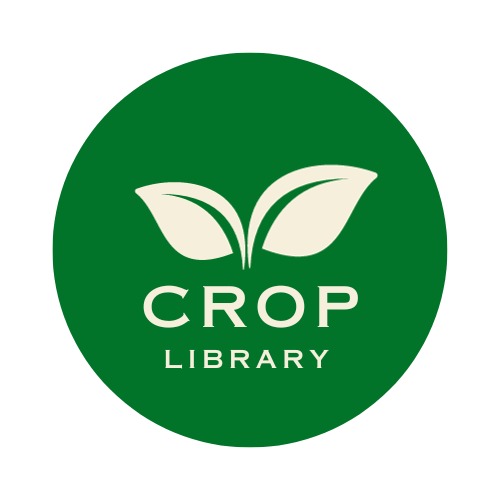
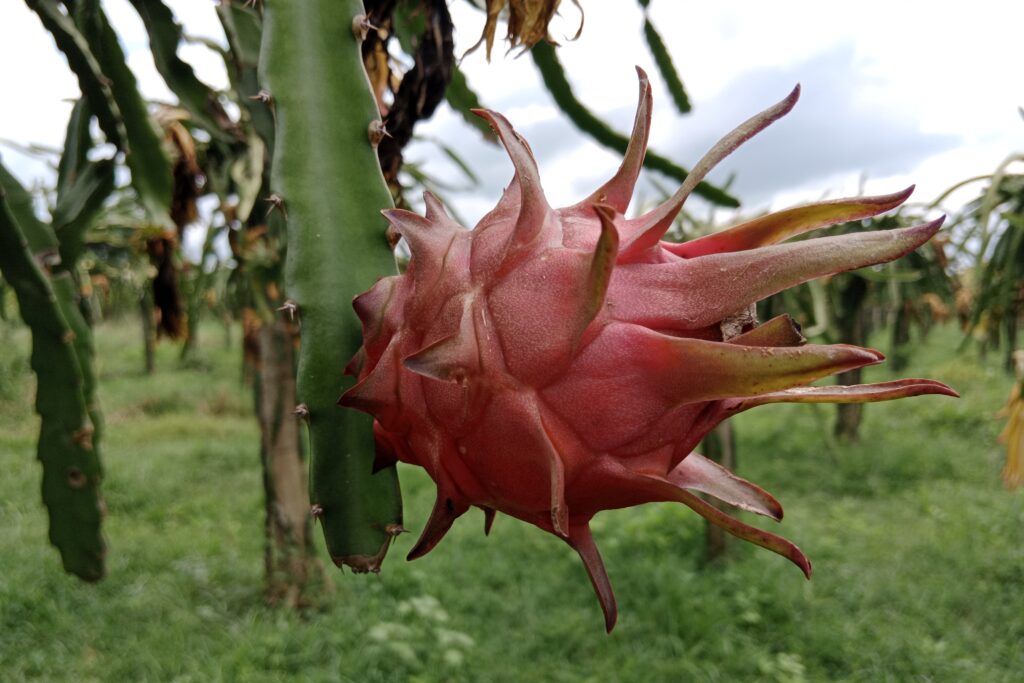
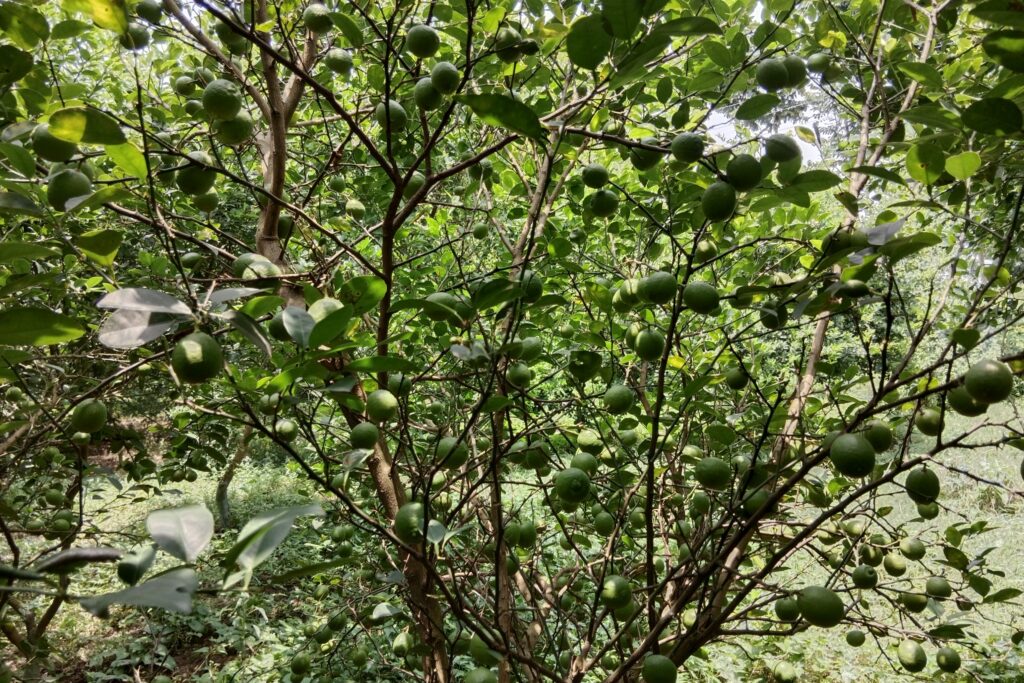
Pingback: Artichoke Farming Profit Per Acre -